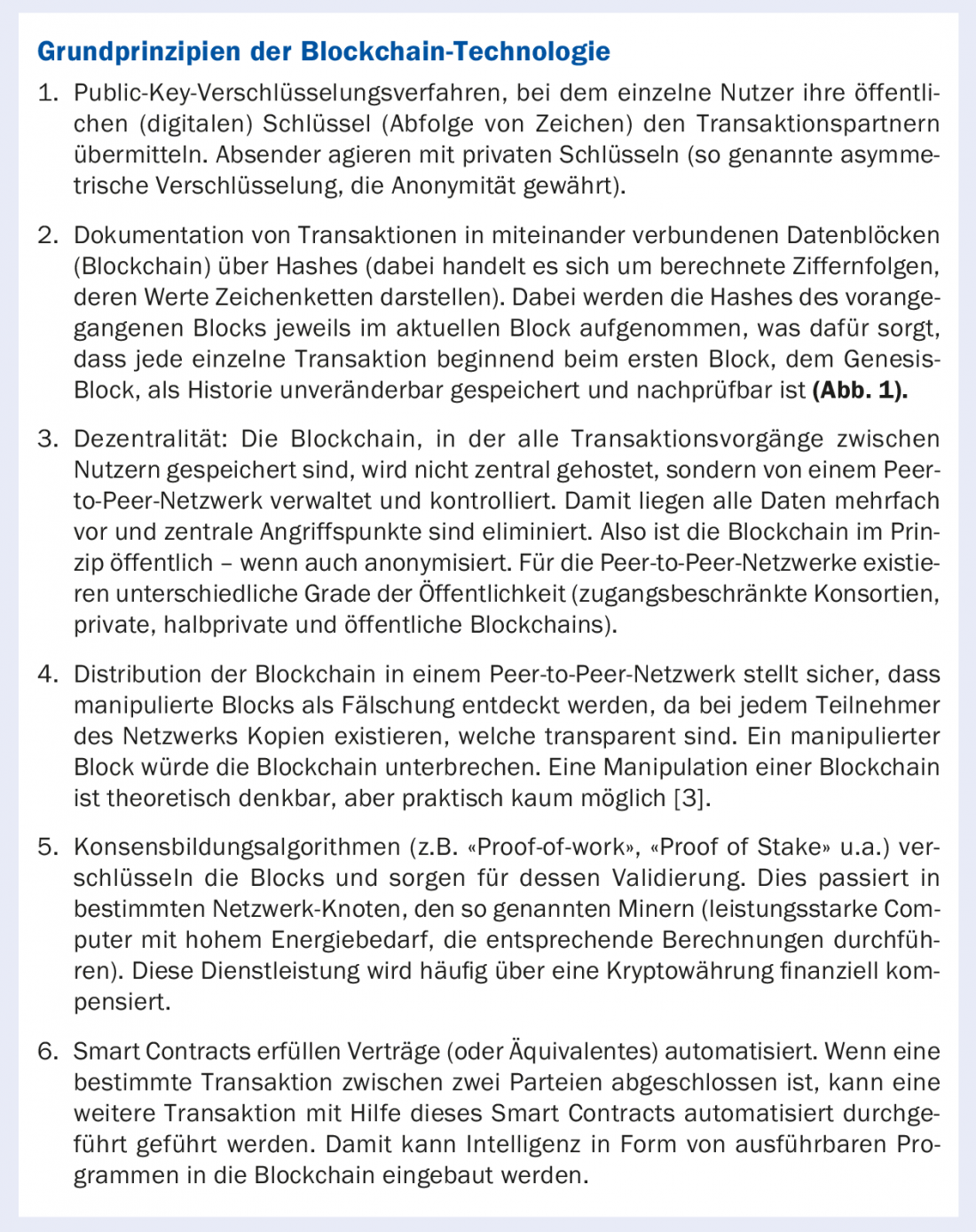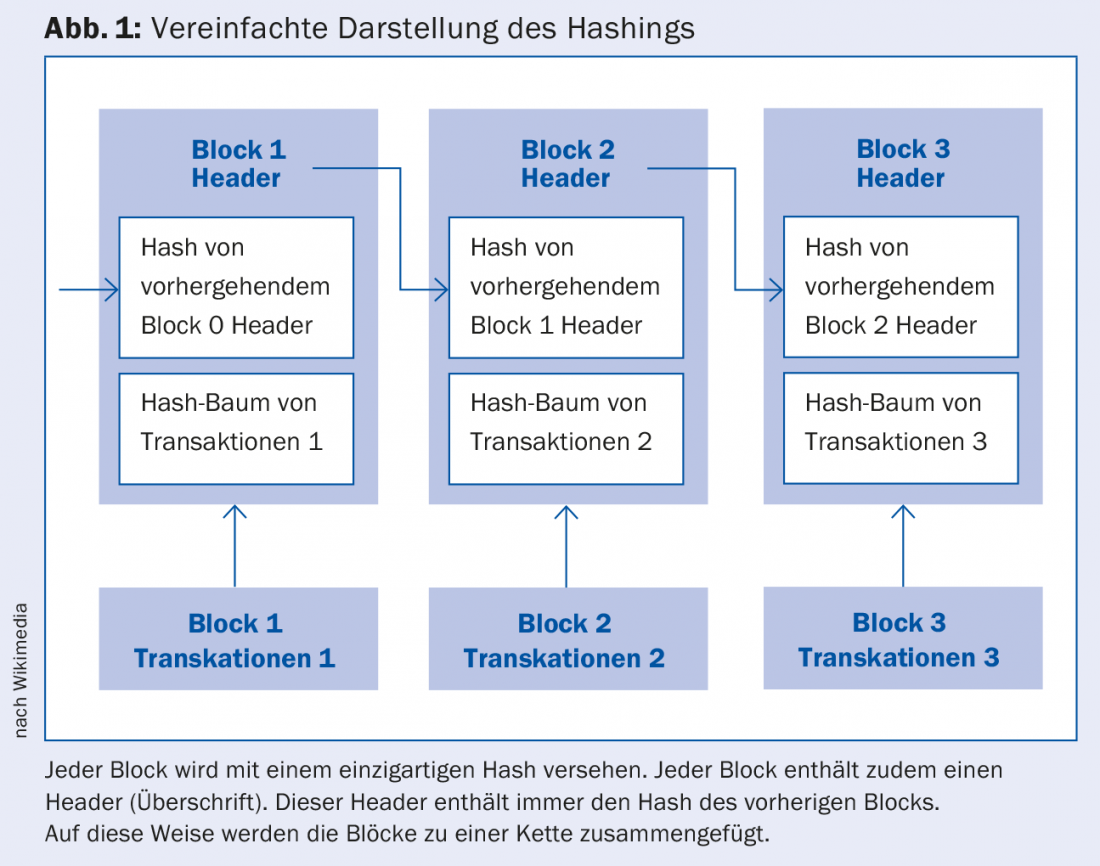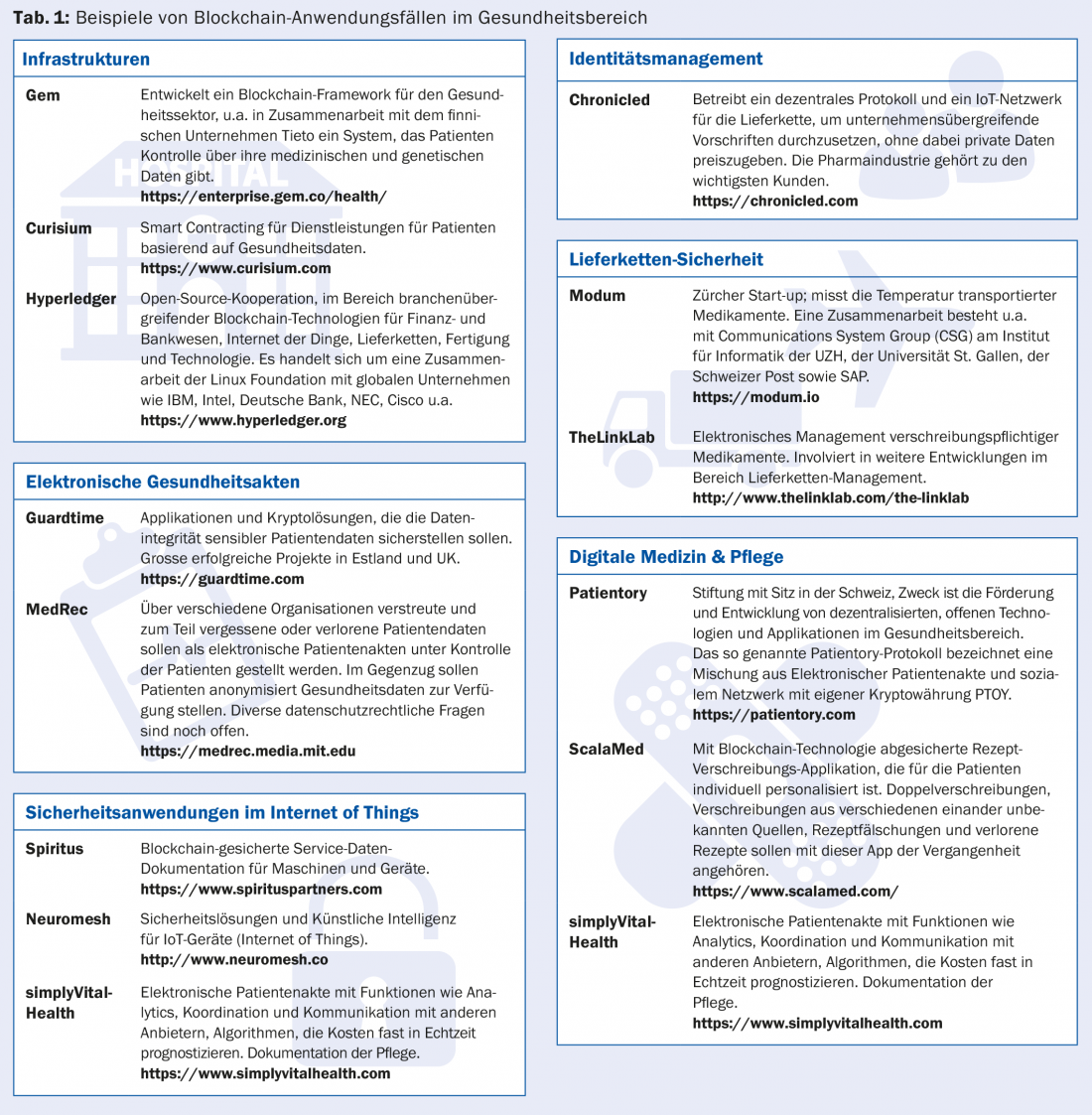Blockchain technology is not only used in the field of cryptocurrency. The concept is also becoming increasingly important in healthcare. How does blockchain technology work? How is it used in the medical field? And what are the opportunities and risks?
In 2008, Sakoshi Nakamoto (pseudonym) [1] was the mastermind behind an electronic payment system that does not require authoritarian authorities such as banks. Several technology concepts have been summarized under the term blockchain, the first implementation of which started in 2009 and made a name for itself with the cryptocurrency Bitcoin. Since that initial spark, blockchain concepts have evolved and become known under new collective terms, such as Etherium. With Etherium, not only the new cryptocurrency Ether was realized, but also the possibility of so-called smart contracts [2]. These are automated contract fulfillments linked to transactions or events. Since then, the blockchain has been present in the media mainly with the exchange value turbulences around various cryptocurrencies.


Disruptive potential
The potential of blockchain technology is revealed in a consideration of the problems it was originally designed to solve. At the time, in 2008, this primarily involved issues of transaction security and digital identity management. Various functional principles have been combined to create a technical solution known as blockchain technology (see box “Basic principles of blockchain technology”). However, different blockchain technologies differ in detail. Their importance for the digital securing of property rights and the cost-efficient processing of transactions represent essential economic factors from which the healthcare and pharmaceutical industries (can) also benefit.
In this context, the objects of transactions are not only currencies, but can also be intangible property or access rights of any kind, for example usage rights, exploitation rights, access codes to physical entities such as buildings or vehicles, or data (e.g. digital patient records or access to these). Other examples include voting rights or certificates and other attestations.
Actors in blockchain transactions can also be machines or things that communicate information into networks, the so-called Internet of Things (IoT) – a shorthand term for machine-to-machine communication, in which state or environmental data recorded via sensors on non-functional objects or in machines and devices is transmitted to other machines.
Healthcare use cases
Blockchain technology is still young and therefore not yet widely used. However, there are already quite a number of internationally active start-ups, that address different use cases (Tab. 1).
Only some of the use cases concern patient data or the electronic patient record itself: The goal of the MedRec project initiated by the MIT media Lab (USA) is to enable patients to grant self-determined access to all or part of the data in their file without the involvement of third parties. Michael Müller, University Psychiatric Hospital Basel, elaborated on other hypothetical use cases in his presentation at this year’s Swiss eHealth Forum in Bern [4]:
- An EPD Registry, an Electronic Patient Dossier (EPD) content registry that manages archives of various patient documents without the need for them to have a central location; and
- the recording/documentation of activities in the EPD throughout the life of the file.
The pioneer of blockchain-secured patient records is Estonia, where technology from Guardtime is in use [5]. The fact that the services in the area of EPD can be expanded in many ways is demonstrated by the development of simplyVitalHealth, which, in addition to various analysis functions, also contains communication functions for interaction between the service providers. Interdisciplinary data exchange, communication and care audit should thus find a central platform.
ScalaMed’s goal is to curb medication misuse, multiple/misprescribing, and lost prescription expense with a tool that patients, physicians, pharmacies, and payers can interact with. The solution: a prescription prescribing app. TheLinkLab deals with the electronic management of prescription drugs from prescription and ordering via wholesalers and pharmacies to the patient. The supply chain for pharmaceutical products is also being targeted by Zurich-based Modum, with the help of the Internet of Things. The temperature during the transport of sensitive pharmaceutical products is tracked and documented and certified in a blockchain.
The selection of use cases in Table 1 shows a small cross-section of application areas for blockchain technology using healthcare as an example. Most of these examples can be transferred to other segments of the economy with technically comparable use cases.

Young technology with imponderables
The blockchain start-up scene is characterized by its high level of dynamism, which is currently still characterized by ongoing business model changes or modifications, immature technology and, in some cases, promises of performance without any real foundation.
What the use cases have in common is that, although they are based on or use the basic blockchain architecture, they have to deal with a much higher level of technical system complexity in detail. Blockchain does not replace this complexity. The blockchain architecture itself is also already in the process of diversifying, which may raise further complexity issues. At the same time, the fledgling technology is still immature, so at this early stage its entry into sensitive data networks is often still viewed critically. Known problems of blockchain technology that have not yet been fully solved relate, for example, to scalability (mining processes require more time than simple transaction processes, for example, for credit card payments), security (in the sense of attacks) [6], and the potential transparency of blockchains, which is not always desired.
Prof. Ursula Sury, Lucerne, points out in her investigation of the data protection aspects of blockchain architecture that there is still a need for clarification here, since not every form of blockchain satisfies current data protection regulations [7]. For example, it lists topics such as responsibility for the system, consent rights of participants in a blockchain for data processing or contracting, and the right to be forgotten. It was also unclear under which jurisdiction data protection claims could be enforced.
What can be considered reputation-damaging in the history of blockchain is its success in the transaction space of the so-called “darknet.” For anonymized, secure transactions in an environment where actors have no basis of trust, blockchain technology proved highly suitable, but this left the psychological stigma of an “unclean” technology. The valuation capers of cryptocurrencies also did not help the public associate the term blockchain with respectability. These phenomena can be seen as the obstructive circumstances that accompany a hype: a topic boils up in the media, is associated with exaggerated expectations, and is then discarded again for the time being, only to enter a maturing phase. Blockchain technology is just becoming a teenager.
Literature:
- Nakamoto S: Bitcoin: A Peer-to-Peer Electronic Cash System, Bitcoin.org 2008; URL: https://bitcoin.org/bitcoin.pdf.
- Buterin V: Ethereum: A Next-Generation Cryptocurrency and Decentralized Application Platform. In: Bitcoin Magazine 2014; https://bitcoinmagazine.com/articles/ethereum-next-generation-cryptocurrency-decentralized-application-platform-1390528211.
- Yin W, Wen Q: An anti-quantum transaction authentication approach in Blockchain 2018; IEEE Access. 6: 5393-5401, https://ieeexplore.ieee.org/stamp/stamp.jsp?arnumber=8242360.
- Müller M, Christen B: Blockchain use case in Swiss healthcare. Presentation Swiss e-Health Forum 08.03.2019, Bern.
- E-estonia: eHealth authority partners with Guardtime to accelerate transparency and auditability in health care, https://e-estonia.com/ehealth-authority-partners-with-guardtime-to-accelerate-transparency-and-auditability-in-health-care.
- Kannenberg A: Malicious miner: 51 percent attack and double-spend against Bitcoin Gold, Heise.de 2018; www.heise.de/newsticker/meldung/Boesartiger-Miner-51-Prozent-Attacke-und-Double-Spend-gegen-Bitcoin-Gold-4058874.html.
- Sury U: Blockchain and privacy In: Informatik Spektrum 2018; 38(2), DOI: 10.10007/s00287-018-1099-9.
HAUSARZT PRAXIS 2018; 13(9): 45-48












